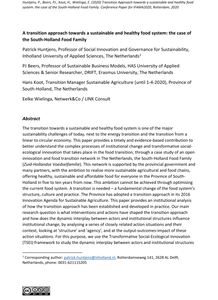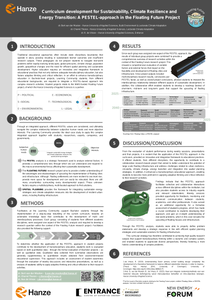A definition of the concepts ‘multidisciplinairy and transdisciplinary work’ and the different types of reaction of social work towards the emergence of multidisciplinary and transdisciplinary approaches.
DOCUMENT

The energy community movement has grown considerably over the past ten years. Energy communities are also expanding their activities. However, room for new energy projects is limited because of grid congestion. Therefore, citizen energy communities (CECs) are looking for ways to reduce the pressure on the grid. Against this background we ask what new roles renewable energy communities can play in grid governance. What opportunities are available to store produced electricity or to balance electricity on a neighborhood level? Are these solutions economically and technically feasible? Our article draws on a recent research project on innovative community energy services in the Netherlands. In three case studies, we investigated local solutions to balance energy production and consumption. We organized workshops and webinars for CECs and carried out interviews and technical studies. Theoretically, we use Social Movement Theory (SMT) to understand the community energy movement. Furthermore, we employ Large Technical Systems (LTS) theories about the lifecycle of infrastructures. We investigated the technical, organizational, and economic aspects of these solutions, as well as skills and knowledge. We conclude that the community energy movement is expanding its activities to new functions in the energy system, but economic feasibility is not yet within reach.
DOCUMENT
The debate on tourism in cities, both academically and in practice, has for a long time taken place in relative isolation from urban studies. Tourism is mostly addressed as an external agent and economic force that puts pressure on cities rather than as an interdependent part of city systems. The recent debate on city touristification and excessive dependence on the visitor economy, as well as the associated processes of exclusion, and displacement of local city users, serves to highlight how tourism is an integral part of urban developments. A wider urban perspective is needed to understand the processes underlying the tourism phenomena and more transdisciplinary perspectives are required to analyze the urban (tourism) practices. The current article seeks to contribute to such a perspective through a discussion of the literature on urban and tourism studies, and related fields such as gentrification, mobilities, and touristification. Based on this, theoretical reflections are provided regarding a more integral perspective to tourism and urban development in order to engage with a transversal urban tourism research agenda.
MULTIFILE
‘Entrepreneurship for Society’ is a new minor program at Amsterdam UAS, the Netherlands. Using the concept of the ‘Doughnut Economy’ by Kate Raworth as theoretical baseline, focus is on social entrepreneurship (SE). The curriculum is designed to foster transdisciplinary collaboration between students and staff from different backgrounds, as well as with partners from the field of social entrepreneurship such as companies themselves, policy makers and citizen initiatives.Apart from its content, the minor is innovative and experimental in three ways:1. Connecting research and education: linking (development of) questions from the SE field to active involvement of students and teachers in the research Lab;2. Transdisciplinary approach; using a problem-solving approach and collaborating with field partners3. Interdepartmental organisation.The minor will premiere in February 2020. We present our approach and the challenges we see, actively seeking feedback and links to scholars who have grappled with similar issues.Scientific blogs assess a quantitatively different set
MULTIFILE

Integrating knowledge and expertise from designers and scientists proposes solutions to complex problems in a flexible and open-minded way. However, little insight is available in how this collaboration works. Therefore, we reflected on a research project aimed at supportive care interventions for child oncology, and detected barriers and enablers for effective designer scientist collaboration. We interviewed medical scientists (n=2), designers (n=5), health care professionals (n=2), design students (n=3), and one design innovation-expert. Enablers appeared a receptive attitude towards innovation, and shared terminology facilitated by participatory design tools, internal communication means, and common goals. Largest barrier was unstable team membership. Future collaborative research projects might benefit when preventing barriers and stimulating enablers.
DOCUMENT

AbstractBackground: Ecological models are currently the most used approaches to classify and conceptualise determinantsof sedentary behaviour, but these approaches are limited in their ability to capture the complexity of and interplaybetween determinants. The aim of the project described here was to develop a transdisciplinary dynamic framework,grounded in a system-based approach, for research on determinants of sedentary behaviour across the life span andintervention and policy planning and evaluation.Methods: A comprehensive concept mapping approach was used to develop the Systems Of Sedentary behaviours(SOS) framework, involving four main phases: (1) preparation, (2) generation of statements, (3) structuring (sorting andranking), and (4) analysis and interpretation. The first two phases were undertaken between December 2013 andFebruary 2015 by the DEDIPAC KH team (DEterminants of DIet and Physical Activity Knowledge Hub). The lasttwo phases were completed during a two-day consensus meeting in June 2015.
DOCUMENT

The transition towards a sustainable and healthy food system is one of the major sustainability challenges of today, next to the energy transition and the transition from a linear to circular economy. This paper provides a timely and evidence-based contribution to better understand the complex processes of institutional change and transformative social-ecological innovation that takes place in the food transition, through a case study of an open innovation and food transition network in The Netherlands, the South-Holland Food Family (Zuid-Hollandse Voedselfamilie). This network is supported by the provincial government and many partners, with the ambition to realize more sustainable agricultural and food chains, offering healthy, sustainable and affordable food for everyone in the Province of South-Holland in five to ten years from now. This ambition cannot be achieved through optimising the current food system. A transition is needed – a fundamental change of the food system’s structure, culture and practice. The Province has adopted a transition approach in its 2016 Innovation Agenda for Sustainable Agriculture. This paper provides an institutional analysis of how the transition approach has been established and developed in practice. Our main research question is what interventions and actions have shaped the transition approach and how does the dynamic interplay between actors and institutional structures influence institutional change, by analysing a series of closely related action situations and their context, looking at 'structure' and 'agency', and at the output-outcomes-impact of these action situations. For this purpose, we use the Transformative Social-Ecological Innovation (TSEI)-framework to study the dynamic interplay between actors and institutional structures influencing institutional change. The example of TSEI-framework application in this paper shows when and how local agents change the institutional context itself, which provides relevant insights on institutional work and the mutually constitutive nature of structure and agency. Above institutional analysis also shows the pivotal role of a number of actors, such as network facilitators and provincial minister, and their capability and skills to combine formal and informal institutional environments and logics and mobilize resources, thereby legitimizing and supporting the change effort. The results are indicative of the importance of institutional structures as both facilitating (i.e., the province’s policies) and limiting (e.g. land ownership) transition dynamics.
DOCUMENT

Traditional educational approaches often include disciplinary boundaries that operate in silo’s, not considering dynamic systems. These pedagogies are insufficient for preparing students to navigate real-world problems within rapidly evolving landscapes, potentially resulting in substandard learner outcomes and insufficient research outputs. This challenge is exacerbated by the increasing myriad of global pressures brought about by climate change, population growth, geopolitical changes and the need for sustainable development. To address these issues, higher education requires an innovative and integrative framework to educational practices that not only delivers adequate transdisciplinary education, but also fosters adaptive thinking and critical reflection. In an effort to enhance transdisciplinary education in Bachelor-level projects, Learning Community students are required to integrate a PESTEL-based approach in complex research activities. Through this integrated approach, we consider different values of PESTEL factors, as well as how education can navigate the complex relationship between subjective human needs and more objective interests. For this purpose, we suggest a step-by-step rebuilding of the current curriculum, towards an actionable knowledge base that contributes to the development of multi- and interdisciplinary processes. Student projects relate to the NWO-funded Floating Future project, of which the Hanze University of Applied Sciences is a partner. It provides an opportunity for students from different disciplines to contribute to collaborative research-based projects that aims to better understand the potential of large scale floating infrastructure and address challenges related to urban resilience, circularity, climate change and energy transition. This article explores the effectiveness of including the PESTEL-framework in the curriculum, and whether it contributes to achieving high quality research outputs that support transdisciplinary systems thinking. Since floating cities and hybrid infrastructure require future-proofing due to a rapidly changing climate, the Learning Community provides the ideal case study to apply this complex integrated approach together with students, researchers, experts, companies, and governments. We employ a mixed-method approach for data collection and analysis, comprising of qualitative and quantitative data. This includes an assessment of student awareness through the evaluation of weekly discussions and interactive presentations, as well as an evaluation of Bachelor projects. Findings indicate that PESTEL facilitates collective and collaborative interactions across different disciplines within the institution, but also provides students access to external experts and relevant stakeholders. This curricular strategy has therefore proven to support transdisciplinary thinking within a dynamic and complex system, and enabled students to appreciate diverse perspectives, thereby fostering a more holistic understanding of complex problems.
DOCUMENT

The research group Participation, Care and Support is part of the Research Centre for Social Innovation of Utrecht University for Applied Sciences. This is a transdisciplinary research centre, doing practice based research focused on relevant social issues, connecting different fields like social work, care, law, employment, policy and organisation. In the centre, around 125 researchers are active and every year several hundreds of students are participating in research projects. Our research group has around 15 members, including people with personal experience with a disability or a mental health issue
LINK
Design and research are two fields of knowledge that each has its traditions, methods, standards and practices. These two worlds appear to be quite separate, with researchers investigating what exists, and designers visualising what could be. This book builds a bridge between both worlds by showing how design and research can be integrated to develop a new field of knowledge. This book contains 22 inspiring reflections that demonstrate how the unique qualities of research (aimed at studying the present) and design (aimed at developing the future) can be combined. This book shows that the transdisciplinary approach is applicable in a multitude of sectors, ranging from healthcare, urban planning, circular economy, and the food industry. Arranged in five parts, the book offers a range of illustrative examples, experiences, methods, and interpretations. Together they make up the characteristic of a mosaic, each piece contributing a part of the complete picture, and all pieces together offering a multi-facted perspective of what applied design research is, how it is implemented and what the reader can expect from it.
MULTIFILE
